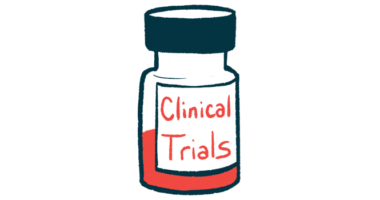#ECTRIMS2022 – Uplizna Helps Reduce Disease-driving Antibodies
Therapy lowers antibody and B-cell counts, regardless of patient's gene variant

Treatment with Uplizna (inebilizumab-cdon) can reduce levels of antibodies that drive neuromyelitis optica spectrum disorder (NMOSD), new clinical trial data show.
The data also show that, among patients who aren’t on Uplizna, NMOSD attacks are often preceded by a sharp rise in levels of disease-driving antibodies and/or antibody-producing B-cells.
Findings were presented at the 38th Congress of the European Committee for Treatment and Research in Multiple Sclerosis (ECTRIMS 2022), in a poster, “Association of B cell subsets and aquaporin-4 antibody titers with disease activity in participants in the N-MOmentum trial receiving inebilizumab treatment.” The work was funded by Horizon Therapeutics, which markets Uplizna.
“These analyses offer more precise illustrations of the differentiated mechanisms of UPLIZNA that are contributing to improved clinical outcomes,” Kristina Patterson, MD, PhD, medical director of neuroimmunology at Horizon, said in a press release. “This is important information for clinicians to consider as they make treatment decisions for their patients because even just one attack can result in devastating consequences, like paralysis and blindness.”
B-cells are a type of immune cell that play a central role in the autoimmune attack that drives NMOSD. B-cells are mainly responsible for making immune proteins called antibodies; NMOSD is usually driven by antibodies called AQP4-IgG that target the aquaporin-4 water channel protein.
What is Uplizna?
Uplizna is a therapy designed to kill B-cells and is approved in the U.S. and Europe to treat NMOSD patients who are positive for AQP4-IgG. It was approved based on data from a Phase 2/3 trial called N-MOmentum (NCT02200770), which compared Uplizna against a placebo in more than 200 NMOSD patients. Findings showed that the treatment could significantly reduce NMOSD attacks and disability.
In a new analysis, researchers at Horizon and other institutions studied data from N-MOmentum where they analyzed how levels of AQP4-IgG and B-cells were changed by treatment, and how these changes were associated with clinical NMOSD attacks.
Results showed that, compared to placebo, Uplizna significantly reduced levels of AQP4-IgG and counts of all B-cell subsets.
At the end of the six-month study, significantly more participants on Uplizna experienced a reduction of at least twofold in AQP4-IgG levels (37% vs. 18%). This difference was especially pronounced (51% vs. 8%) among participants with very high AQP4-IgG levels at the trial’s start (titers higher than 1:20,480).
“This is important information for clinicians to consider as they make treatment decisions for their patients because even just one attack can result in devastating consequences, like paralysis and blindness.”
Among patients on placebo — but not those on Uplizna — AQP4-IgG levels during clinical NMOSD attacks were significantly increased compared to the start of the study. However, overall changes in AQP4-IgG levels from the study’s start to the time of the attacks did not significantly differ between the two groups.
At the time of their NMOSD attacks, patients on Uplizna did not show a notable increase in any B-cell subsets. By contrast, in more than half (57%) of patients on placebo who experienced a clinical attack, the attack was preceded by increases in levels of mature, antibody-producing B-cells called plasma cells.
In fact, 85% of the NMOSD attacks in patients on placebo were preceded by an increase in plasma cells and/or AQP4-IgG levels. Increases in other subtypes of B-cells were seen in some patients in the placebo group at the time of their attack, but not as commonly as increases in plasma cells.
“These findings suggest that plasmablasts [plasma cell precursors] and plasma cells may play a more crucial role in NMOSD attacks than was previously understood,” said Bruce Cree, MD, PhD, a professor of clinical neurology at the University of California San Francisco and co-author of this study.
Uplizna works by binding to a protein on the surface of B-cells, which activates a biochemical pathway called antibody-dependent cellular cytotoxicity (ADCC) to kill the cell. One of the molecules that is centrally involved in ADCC is a receptor protein called Fc gamma receptor III-A (FCGR3A).
Two common forms of the gene provide instructions for making the FCGR3A protein: an “F” genotype and a “V” genotype. These variants lead to productions of slightly different forms of the FCGR3A protein and may affect its functionality — which, theoretically, could mean that Uplizna may not work as well in people with certain variants.
In a separate poster at ECTRIMS, researchers conducted an analysis, also funded by Horizon, that compares outcomes in N-MOmentum for patients with different variants in this gene. The poster was titled “Inebilizumab reduces attack risk independent of low affinity igG Fc region receptor III-a gene polymorphisms in neuromyelitis optica spectrum disorder.”
Results broadly showed that clinical outcomes, such as attack rate and disability progression, were comparable among people with different genotypes. The effect on B-cell counts was also comparable.
“[Uplizna]-treated participants in the N-MOmentum trial did not demonstrate differences in clinical outcomes between those with F and V allele genotypes,” the researchers concluded, adding that the results indicate Uplizna is a promising treatment option for patients, regardless of their FCGR3A genotype.








